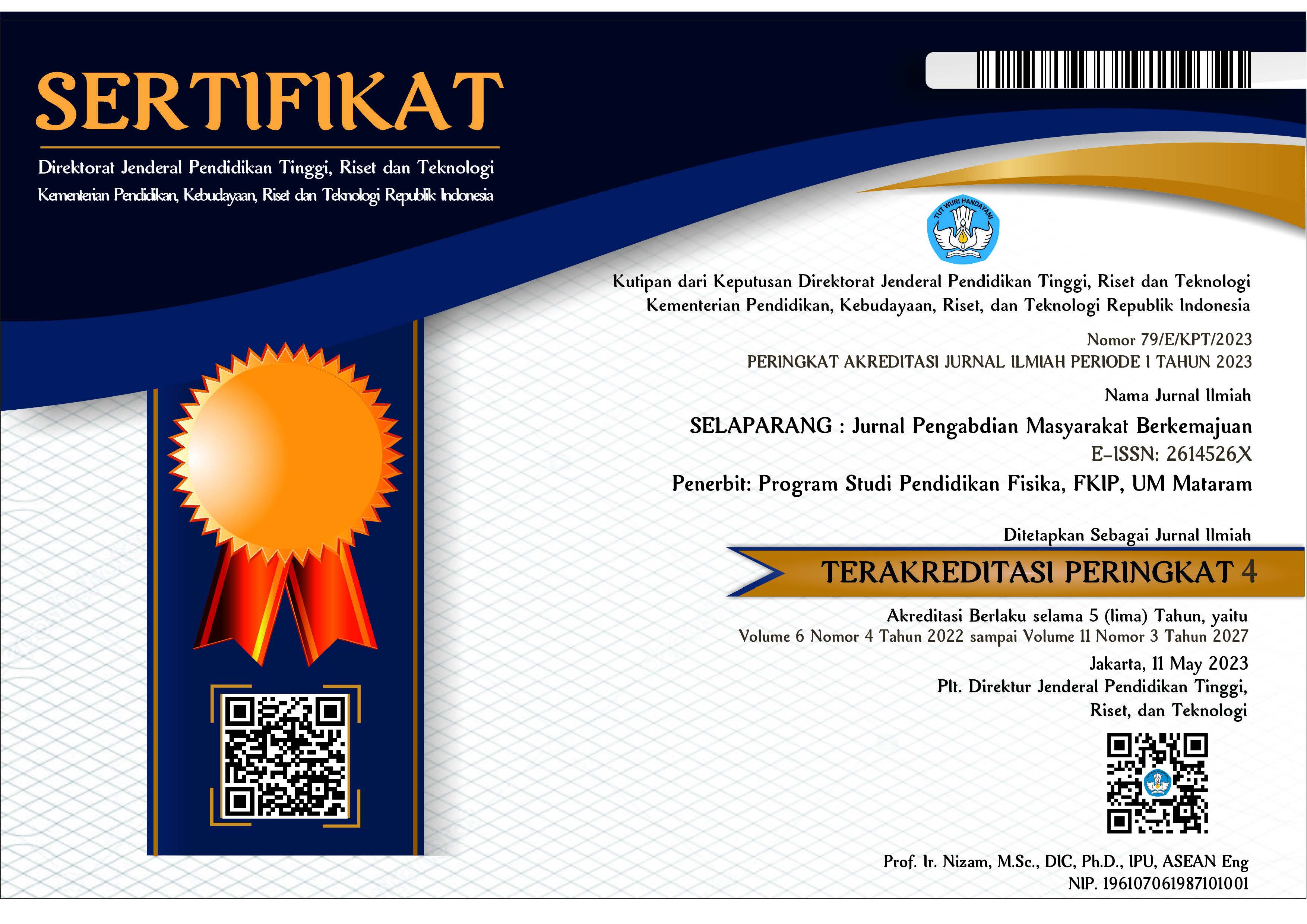PEMANFAATAN SAMPAH PLASTIK DALAM UPAYA MERAWAT LINGKUNGAN DALAM PENCEGAHAN MALARIA DI KAMPUNG YOBOI PAPUA
Abstract
ABSTRAK
Malaria masih menjadi permasalahan di wilayah Indonesia bagian timur yang berpotensi meningkatkan angka kematian pada bayi, ibu hamil dan masyarakat lainnya. Malaria secara tidak langsung berdampak pada produktivitas dan merugikan masyarakat secara ekonomi. Keadaan ini di perburuk oleh kondisi lingkungan tempat tinggal masyarakat di Wilayah Kampung Yoboi, Distrik Sentani Kota, Kabupaten Jayapura Papua yang tidak bersih dan kurangnnya pengolahan sampah yang dilakukan. Kondisi tersebut harus segara ditangani melalui pemberdayaan pemanfaatan sampah plastik dalam upaya merawat lingkungan dalam pencegahan malaria. Tujuan kegiatan pengabdian kepada masyarakat ini adalah untuk meningkatkan kesadaran dan kemampuan masyarakat dalam mengolah sampah plastik dalam upaya merawat lingkungan dalam pencegahan malaria. Pelaksanaan kegiatan dilakukan di Kampung Sereh Papua dengan metode pemberdayaan atau pelatihan pemanfaatan sampah plastik sehingga memiliki nilai guna sehingg dapat merawat lingkungan dan terhindar dari penyakit malaria. Kegiatan diikuti anak-anak yang berjumlah 28 orang berusia 4-7 tahun yang berada di Wilayah Kampung Yoboi, Distrik Sentani Kota, Kabupaten Jayapura Papua. Evaluasi kegiatan dilakukan dengan melihat hasil pemanfaatan sampah plastik menjadi produk yang mempunyai nilai fungsional. Hasil pemberdayaan yang dilakukan dapat membantu mengurangi jumlah sampah plastik di Wilayah kampung Yoboi dan dapat menumbuhkan kreatifitas masyarakat dalam memanfaatkan sampah menjadi produk yang mempunyai nilai fungsional seperti seperti pot untuk tanaman, mainan untuk anak-anak yang terbuat dari plastik dan bunga hias yang terbuat dari plastik serta menjaga lingkungan dalam upaya pencegahan malaria.
Kata kunci: sampah plastik; lingkungan; malaria.
ABSTRACT
Malaria is still a problem in eastern Indonesia which has the potential to increase mortality rates in infants, pregnant women and other communities. Malaria indirectly impacts productivity and harms society economically. This situation is exacerbated by the environmental conditions where people live in the Yoboi Village Area, Sentani Kota District, Jayapura Papua Regency which is not clean and the lack of waste processing carried out. This condition must be immediately addressed through empowering the use of plastic waste in an effort to care for the environment in malaria prevention. The purpose of this community service activity is to increase public awareness and ability to process plastic waste in an effort to care for the environment in malaria prevention. The implementation of activities is carried out in Sereh Papua Village with empowerment methods or training on the use of plastic waste so that it has use value so that it can care for the environment and avoid malaria. The activity was attended by 28 children aged 4-7 years who were in the Yoboi Village Area, Sentani Kota District, Jayapura Papua Regency. Evaluation of activities is carried out by looking at the results of utilizing plastic waste into products that have functional value. The results of the empowerment carried out can help reduce the amount of plastic waste in the Yoboi village area and can foster community creativity in utilizing waste into products that have functional value such as pots for plants, toys for children made of plastic and decorative flowers made of plastic and protecting the environment in efforts to prevent malaria.
eyword: plastic waste; environment; malaria
Keywords
Full Text:
PDFReferences
Aminudin, & Nurwati. (2019). Pemanfaatan Sampah Plastik menjadi Kerajinan Tangan Guna Meningkatkan Kreatifitas Warga Sekitar Institut Teknologi dan Bisnis Ahmad Dahlan ( ITB-AD ) Jakarta. Jurnal ABDIMAS BSI, 2(1), 66–79. https://ejournal.bsi.ac.id/ejurnal/index.php/abdimas/article/download/4515/2943
Ariany, Z., Indriana, Maulana, A. W., Rochana, N. . N., & Pudjonarko, D. (2019). Pemberdayaan Masyarakat dalam Pengelolaan Sampah Berwawasan Lingkungan di Desa Puncel Kabupaten Pati. Jurnal Pengabdian Vokasi, 01(02), 69–72. https://ejournal2.undip.ac.id/index.php/jpv/article/view/5171
Aznuriyandi, A., Erti, L., & Murnawati, M. (2019). Pelatihan Keterampilan Pemanfaatan Limbah Botol Plastik Menjadi Lavitrap Di Kelurahan Sidomulyo Timur Kecamatan Marpoyan Damai Pekanbaru. Diklat Review : Jurnal Manajemen Pendidikan Dan Pelatihan, 3(1), 67–70. https://doi.org/10.35446/diklatreview.v3i1.331
Castro, M. C. (2017). Malaria transmission and prospects for malaria eradication: The role of the environment. Cold Spring Harbor Perspectives in Medicine, 7(10). https://doi.org/10.1101/cshperspect.a025601
Chaukura, N., Gwenzi, W., Bunhu, T., Ruziwa, D. T., & Pumure, I. (2016). Potential uses and value-added products derived from waste polystyrene in developing countries: A review. Resources, Conservation and Recycling, 107, 157–165. https://doi.org/https://doi.org/10.1016/j.resconrec.2015.10.031
Dinas Kesehatan Provinsi Papua. (2016). Unit Pelaksana Teknis AIDS, TBC, Malaria. Dinas Kesehatan Provinsi Papua. http://www.nabire.net/tag/kepala-unit-pelaksana-teknis-aids-tb-dan-malaria/
Dinkes Jayapura. (2018). Profil Kesehatan tahun 2018 (Data 2017). Dinas Kesehatan Jayapura.
Fornace, K. M., Brock, P. M., Abidin, T. R., Grignard, L., Herman, L. S., Chua, T. H., Daim, S., William, T., Patterson, C. L. E. B., Hall, T., Grigg, M. J., Anstey, N. M., Tetteh, K. K. A., Cox, J., & Drakeley, C. J. (2019). Environmental risk factors and exposure to the zoonotic malaria parasite Plasmodium knowlesi across northern Sabah, Malaysia: a population-based cross-sectional survey. The Lancet Planetary Health, 3(4), e179–e186. https://doi.org/10.1016/S2542-5196(19)30045-2
Hidayah, E. N., Maulana, A. A., & Cahyonugroho, O. H. (2021). Sosialisasi Pengelolaan Sampah Kertas, Plastik Dan Logam Melalui Bank Sampah Di Kawasan Perumahan. SELAPARANG Jurnal Pengabdian Masyarakat Berkemajuan, 4(2), 108. https://doi.org/10.31764/jpmb.v4i2.3347
Mokuolu, O. A., Coker, A. O., & Sridhar, M. K. C. (2016). Contributions of solid wastes disposal practice to malaria prevalence in Ilorin, Nigeria. Nigerian Journal of Technological Development, 13(1), 1. https://doi.org/10.4314/njtd.v13i1.1
Muis, A. A., Mursalim, N., Nacjmi, N. Y., Setiawan, I., S, N., Aris, M. R., Asdar, M., Ramadhani, S., Afdal, A., & Aziza, N. (2022). Pemanfaatan Sampah Plastik Dalam Upaya Merawat Lingkungan Guna Menumbuhkan Kreativitas Masyarakat. Community Development Journal : Jurnal Pengabdian Masyarakat, 2(3), 611–617. https://doi.org/10.31004/cdj.v2i3.2484
Okunlola, O. A., & Oyeyemi, O. T. (2019). Spatio-temporal analysis of association between incidence of malaria and environmental predictors of malaria transmission in Nigeria. Scientific Reports, 9(1), 1–11. https://doi.org/10.1038/s41598-019-53814-x
Prasetyo, R. A., Sumekar, D. W., Saftarina, F., & Sukohar, A. (2018). The Difference Knowledge of The Community Before and After Health Education of The Implementation Waste Bank as A Preventive Action of Malaria In The Village of Suka Jaya Lempasing District of Pesawaran Lampung Province. Medical Journal Of Lampung University, 7(1), 171–176. http://juke.kedokteran.unila.ac.id/index.php/majority/article/view/1866
Rafdinal, R., Lestari, D., Ashari, A. M., Apindiati, R. K., & Aritonang, A. B. (2022). Usaha Pencegahan Penularan Penyakit Malaria melalui Sosialisasi Bersih Lingkungan Ekowisata Mangrove Kuala Mempawah. Lumbung Inovasi: Jurnal Pengabdian Kepada Masyarakat, 7(4), 670–675. https://doi.org/10.36312/linov.v7i4.981
Setyowati, R., & Mulasari, S. A. (2013). Pengetahuan dan Perilaku Ibu Rumah Tangga dalam Pengelolaan Sampah Plastik. Kesmas: National Public Health Journal, 7(12), 562. https://doi.org/10.21109/kesmas.v7i12.331
Wahyudi, Raharjo M, & Sulistiyani. (2023). Malaria Vector Surveillance in Kepulauan Seribu as Threat in DKI Jakarta. Jurnal Eduhealth, 14(01), 208. http://ejournal.seaninstitute.or.id/index.php/healt
DOI: https://doi.org/10.31764/jpmb.v7i2.15178
Refbacks
- There are currently no refbacks.

This work is licensed under a Creative Commons Attribution-ShareAlike 4.0 International License.
______________________________________________________
Jurnal Selaparang
p-ISSN 2614-5251 || e-ISSN 2614-526X
EDITORIAL OFFICE:



















